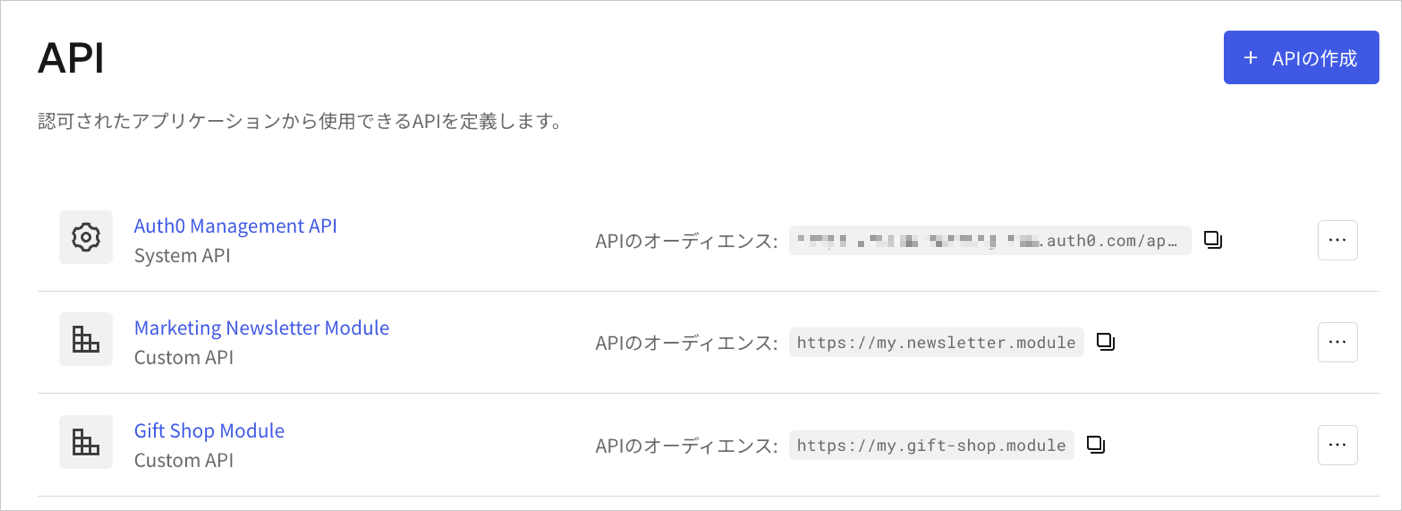scopeクレームに含まれます。RBACを無効にすると、アプリケーションがAPIに定義された任意の権限を要求できるようになり、scopeクレームには要求されたすべての権限が含まれます。
アクセストークンのスコープを変更するActions
Dashboard
-
[Dashboard]>[Applications (アプリケーション)]>[API]に移動し、表示するAPI名をクリックします。

-
[RBAC Settings(RBACの設定)] までスクロールして、[Enable RBAC(RBACを有効にする)] トグルを有効にします。

-
ユーザーに割り当てられたすべての権限をアクセストークンの
permissionsクレームに含めるには、[Add Permissions in the Access Token(アクセストークンに権限を追加する)] トグルを有効にして、[Save(保存)] をクリックします。アクセストークンに権限を含めると、最小限の呼び出しで権限を取得できますが、トークンのサイズは大きくなります。[Add Permissions in the Access Token(アクセストークンに権限を追加する)] トグルを有効にすると、Auth0はAPIに設定されたアクセストークンプロファイルを基に、トークンのダイアレクトも更新します。- トークンのダイアレクトが
access_tokenの場合、Auth0はこれをaccess_token_authzに更新します。これは、permissionsクレームを含むaccess_tokenプロファイルと同等です。 - トークンのダイアレクトが
rfc9068_profileの場合、Auth0はこれをrfc9068_profile_authzに更新します。これは、permissionsクレームを含むrfc9068_profileと同等です。
- トークンのダイアレクトが
Mangement API
を使用してRBACを有効にするには、リソースサーバー更新エンドポイントにPATCH要求を行います。PATCH要求で、enforce_policiesをtrueに設定します。
以下の表が示すように、API_ID、MGMT_API_ACCESS_TOKEN、TOKEN_DIALECTをそれぞれの値に置き換えます。
| パラメーター | 説明 |
|---|---|
API_ID | RBACを有効にしたいAPIのID。 |
MGMT_API_ACCESS_TOKEN | スコープupdate:resource_serversを持つManagement APIのアクセストークン。 |
TOKEN_DIALECT | 指定されたAPIのアクセストークンのダイアレクト。詳しくは、「トークンのダイアレクトオプション」をご覧ください。 |
トークンのダイアレクトオプション
Auth0は以下のトークンダイアレクトに対応しています。| 値 | 説明 |
|---|---|
access_token | デフォルトのAuth0トークンプロファイルはJSON Web Token(JWT)形式のアクセストークンを生成します。アクセストークンのscopeクレームには、要求された権限とユーザーに割り当てられた権限の共通部分が含まれます。permissionsクレームは渡されません。詳細については、「アクセストークンのプロファイル」をお読みください。 |
access_token_authz | permissionsクレームのあるデフォルトのAuth0トークンプロファイル(access_token)です。アクセストークンのscopeクレームには、要求された権限とユーザーに割り当てられた権限の共通部分が含まれます。アクセストークンのpermissionsクレームには、ユーザーに割り当てられたすべての許可が含まれます。アクセストークンに許可を含めると、最小限の呼び出しで許可を取得できますが、トークンサイズは大きくなります。 |
rfc9068_profile | IETF JWT Profile for OAuth 2.0 Access Tokens(RFC 9068)に準拠したJWT形式のアクセストークンを生成します。アクセストークンのscopeクレームには、要求された権限とユーザーに割り当てられた権限の共通部分が含まれます。permissionsクレームは渡されません。詳細については、「アクセストークンのプロファイル」をお読みください。 |
rfc9068_profile_authz | permissionsのあるRFC 9068トークンプロファイル(rfc9068_profile)。アクセストークンのscopeクレームには、要求された権限とユーザーに割り当てられた権限の共通部分が含まれます。アクセストークンのpermissionsクレームには、ユーザーに割り当てられたすべての許可が含まれます。アクセストークンに許可を含めると、最小限の呼び出しで許可を取得できますが、トークンサイズは大きくなります。 |

